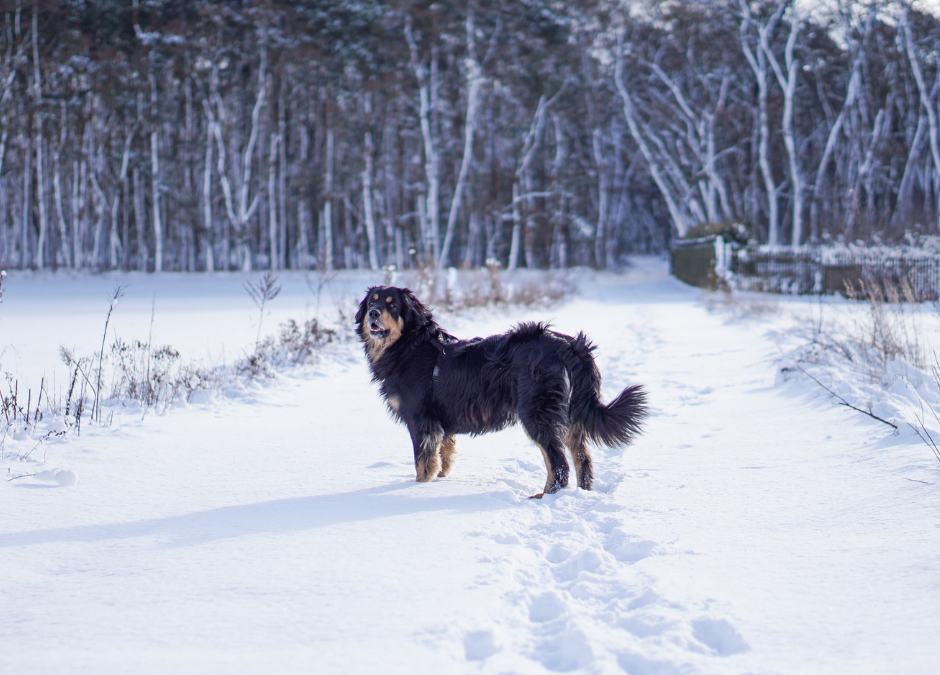Cold weather affects every breed differently. Some dogs are built for it; some are not. Age, size, and health also play an important factor in cold weather care for dogs. Here are answers to some common questions to help ensure your pup is comfortable and safe throughout winter.
Does my dog need more food in the winter?
If your dog is an active breed, it will burn more calories in the cold. Active dogs may need more calorie-dense food in the wintertime. There are some performance foods made specifically for cold-weather care for dogs. This food enables faster digestion, which gives them a maximized metabolism the following day.
If your furry friend is not active due to age or health complications, increasing their winter food intake may not be necessary. If they go outside even less because of the cold, they may need a food reduction.
Is your dog in a healthy weight range?
- Can you feel their ribs when they’re resting or breathing?
- Do you see a “tuck” in their belly, or does it bulge?
When viewed from above, dogs should have a slight hourglass figure, and their belly should not bulge. Being able to feel or see their ribs does not mean they are starving. Be sure to adjust their food intake up or down to ensure they have adequate nutrition for the cold weather but aren’t gaining weight due to lower activity levels.
Does my dog need more water in the winter?
It’s easy to forget about hydration during the winter, as it doesn’t seem as important when we’re not sweating from the heat. Yet, hydration can be even more critical during the winter, especially if there’s an increase in food intake. Dogs require an increase in water any time their food intake is increased. Access to an abundant fresh water supply is imperative for a dog. They need it to digest their food, absorb nutrients, keep their organs functioning at optimal levels, and regulate body temperature.
Does my dog need snow boots?
Another aspect of cold weather care for dogs is their paws. Once again, the need depends on the activity level and type of activity the dog will be performing. Ice and snow can cause injury to a dog’s paws. Dog booties may be necessary, especially in extreme conditions. If walking your dog on sidewalks where salt or ice melt has been used, keep in mind that many salt formulas can irritate their paws or even cause chemical burns with too much exposure. Deep, hard snow can also cause injury from abrasions, so it may also be necessary to wrap your dog’s legs above the snow booties.
Small, old, and hairy dogs can also have issues with snow being caked in between and in the hair of their paws and body. While this may not cause injury, it can be uncomfortable and make them less likely to go outside when needed, leading to other issues. A quick and easy way to keep this from happening is to use a jacket and booties and check for snow clumps when they come back in.
How long is it safe for my dog to be outside in the cold?
If you have a dog who lives inside and goes out in the yard to do their business and play, they’ll likely tell you when they’re ready to come back inside. Larger dogs and breeds with thicker coats can typically stay out longer than smaller dogs, but pay attention to the timeframe and bring your dog back inside regularly. Dogs who live outside or spend extended periods outdoors should have adequate shelter from the wind and cold — typically a doghouse-filled straw and blankets. In periods of extreme cold, all dogs should be brought inside to keep them warm.
At the end of the cold winter day, the important thing to remember is that you know your dog better than anyone. You can tell when they’re in pain or uncomfortable. That knowledge, plus learning the basics of cold weather care for dogs, will help you keep your dog comfortable and safe during winter weather.
Having trouble with your pup? Pulling the leash, barking, showing dominant behavior at the dog park? We can help.

